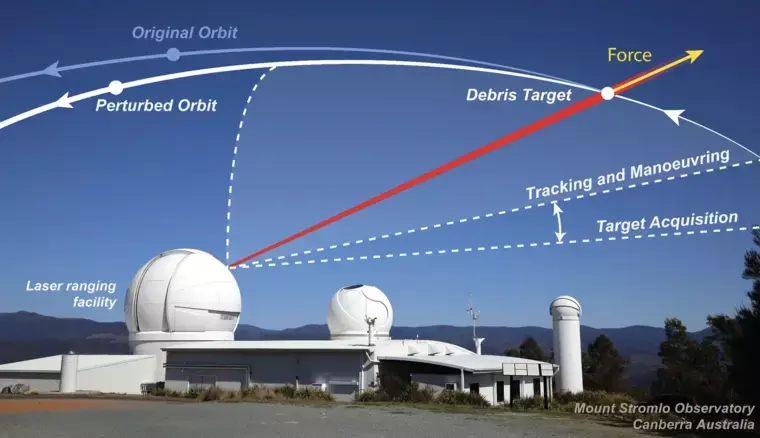In an initiative that could redefine space safety, the Japanese-based startup EX-Fusion plans to test a ground-based fusion laser system to “capture, remove, or push out” objects operating in Earth’s orbit.
In a statement announcing a partnership with the Australian company EOS Space Systems, EX-Fusion said they aim to use ground-based laser systems to address the mounting problem of space debris, a growing concern for global space agencies and satellite operators.
“In recent years, the number of space debris around the Earth has increased significantly, leading to catastrophic collisions with valuable space assets essential to life on Earth, such as telecommunications, finance, location, and navigation,” EX-Fusion said in a press release. “One effective strategy for mitigating the space debris problem is to utilize optical ground stations equipped with high-power laser systems to remove or redirect space debris and avoid these catastrophic collisions.”
Space debris, consisting of defunct satellites, spent rocket parts, and fragments from collisions, poses a significant risk to operational satellites, crewed missions, and the International Space Station.
The U.S. military currently tracks objects over 10 centimeters in orbit, but smaller, harder-to-detect fragments have increasingly become a threat. The European Space Agency (ESA) estimates there are more than 175 million pieces of space debris, measuring 1 mm to 1 cm, currently floating around Earth orbit.
According to the ESA, a collision with a 1 cm piece of space debris could disable a spacecraft or penetrate the protective shields of the International Space Station. Impact from a 10 cm or larger object would result in “catastrophic fragmentation of a typical satellite.”
As the number of space-related activities surges worldwide, the urgency to address the issue of space debris, including enforcement against space litterbugs, has intensified.
In October 2023, the U.S. Federal Communications Commission (FCC) levied a $150,000 fine against Dish Network for failing to deorbit its EchoStar-7 satellite properly. The action marked the first time a company has faced enforcement action for contributing to the growing space debris problem.
The use of lasers to tackle space debris is not a novel concept. In October 2023, NASA announced it was partnering with West Virginia University (WVU) to develop a system of space lasers to defend spacecraft from catastrophic collisions with space debris.
“Our goal is to develop a network of reconfigurable space-based lasers, along with a suite of algorithms,” Hang Woon Lee, the director of the Space Systems Operations Research Laboratory at WVU, explained in a press release. “Those algorithms will be the enabling technology that makes such a network possible and (to) maximize its benefits.”
However, unlike other satellite-based laser solutions, EX-Fusion plans to leverage its expertise in laser technology to target space junk from the ground.
According to the Japanese news outlet Nikkei Asia, EX-Fusion intends to test its technology by placing a high-powered fusion laser at the EOS Space Systems-operated observatory outside Canberra, Australia.
Nikkei reported that the project will be divided into two phases, the first aiming to track debris smaller than 10 cm. The subsequent phase will involve increasing a ground-based laser’s power to decelerate and remove the debris by directing it into Earth’s atmosphere for safe incineration.
EX-Fusion’s partner on the project, EOS Space Systems’ existing technologies include operational systems for optical tracking and laser ranging of space debris orbiting Earth. EOS also offers a high-energy laser (HEL) weapon system as part of the company’s defense portfolio.
According to the company’s website, the EOS HEL can take “swift and decisive action” against unmanned aerial systems (UAS). A product sheet for the laser weapon says the system can engage drone threats at a range of up to 2.5 miles.
As geopolitical tensions rise around the use of space, the strategic value of possessing a ground-based “satellite killer” is becoming increasingly apparent, potentially serving as a critical component in a nation’s military capabilities.
However, in a November visit to Japan, EOS Space’s executive vice president, James Bennett, said the high-powered lasers EX-Fusion will be using to remove space debris are entirely different from the weapon-grade lasers used in military applications.
EX-Fusion’s system utilizes diode-pumped solid-state (DPSS) lasers to apply pulsed energy to fast-moving debris, effectively functioning as brakes to slow down and remove the fragments.
The company’s DPSS laser technology was initially developed with the ambitious goal of “building and powering” the world’s first laser fusion nuclear reactor.
Laser fusion works by irradiating a powerful laser beam onto a hydrogen fuel pellet several millimeters in size to generate a high-pressure “implosion,” triggering a nuclear fusion reaction, EX-Fusion explains on its website.
“The power of a laser for destroying space junk is an order of magnitude lower than for nuclear fusion, but they share technical challenges such as controlling them via special mirrors,” EX-Fusion CEO Kazuki Matsuo told Nikkei.
EOS Space Systems previously proposed the idea of using a similar ground-based photon pressure system to remotely maneuver space debris at the 2018 International Workshop of Space Debris.
Using ground-based fusion lasers to successfully remove space debris is a daunting task.
Targeting tiny, rapidly moving objects in space from the Earth’s surface requires exact tracking and aiming systems. Atmospheric interference also poses a significant challenge, with variations in atmospheric density potentially deflecting and weakening laser beams, reducing their effectiveness.
The power of the laser will also be a critical factor. The beam must be strong enough to impact the debris yet controlled to avoid collateral damage to nearby operational satellites.
Finally, the time and location of the laser firing must be carefully calculated to ensure the debris, once impacted, safely re-enters the Earth’s atmosphere without posing a risk to other space assets.
Overcoming these concerns will require a mix of advanced technology and sophisticated engineering solutions.
Despite these challenges, EX-Fusion views them as a prime opportunity to demonstrate the commercial viability of laser fusion technology.
Tim McMillan is a retired law enforcement executive, investigative reporter and co-founder of The Debrief. His writing typically focuses on defense, national security, the Intelligence Community and topics related to psychology. You can follow Tim on Twitter: @LtTimMcMillan. Tim can be reached by email: tim@thedebrief.org or through encrypted email: LtTimMcMillan@protonmail.com

